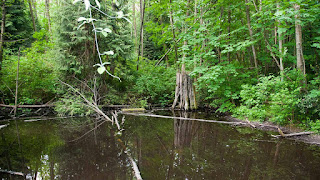Camosun Bog Essay RT
Camosun Bog

A bog is formed when a lake slowly fills with plant debris. Sphagnum moss, as well as other plants, grow out from the lake's edge. Bogs can also form when the sphagnum moss covers dry land and prevents precipitation from evaporating.
Sphagnum moss is the keystone of a bog, also sometimes called “peat
moss”, without this the big would not exist. It maintains the wet and
acidic conditions of the bog and as the ability to absorb tons of water. "Sphagnum maintains its acidic conditions by absorbing water and
pumping hydrogen ions into its surroundings."
Peat is an accumulation of partially decayed vegetation or organic matter which helps a lot with water management and is a great habitat for wildlife. Peat is the same colour as soil however, peat has a different texture and weight, making it light and spongy which reduces drainage of water from soil. Digging through a bog is like digging through time because each metre below the surface represents about 400 years. Occasionally human bodies are found in bogs, exquisitely preserved by the acidic peat as well as other old artifacts.
Many different artifacts have been found in the Camosun Bog such as an old
hockey puck, large numbers of glass marbles, button hat, and different types
of coins.
Some observations the old woman made while remembering herself playing
hockey in Camosun bog was her having to play goalie because she could not
skate as well as everyone else at the age of about 8 or 9 with no skates!
Sometimes during lunch hour she would go on the ice and slide, sometimes
even skate. The woman also remembered the trees around the bog being
only 10 or 15 feet tall at the time and used to go around the bog and pick
out huckleberries
Bog are carbon sink and important because they remove CO2 from the
atmosphere and storing it in recalcitrant forms of carbon where acidic and
water logged conditions prevent decomposition. This draws carbon dioxide
from the atmosphere and goes through plants, especially Sphagnum mosses
which are located in bogs. The role of carbon sinks in preventing carbon
levels to rise is of paramount importance.
 Musqueam people’s have been using the area of the Camosun bog for over
3,500 years for food, medicine, and culture. This area was also used by
Musqueam peoples for fishing, hunting, trapping and gathering.
Musqueam people’s have been using the area of the Camosun bog for over
3,500 years for food, medicine, and culture. This area was also used by
Musqueam peoples for fishing, hunting, trapping and gathering.
The Camosun Bog was nearly destroyed due to population pressure,
dumping, native species, and an overall lack of care and understanding.
The change in abiotic conditions caused "natives" to go into the bog are
plants known as, Labrador tea, western bog laurel, salal, lodgepole pine,
sphagnum mosses, sundew and skunk cabbage. Types of native plants in
bogs include, Sundew, Cloudberry, Labrador tea, Bog Laurel, Bog Cranberry,
and Pine Trees.


Laurence. “Camosun Bog.” Camosun Bog, 16 May 2011, camosunblog.blogspot.com/2011/05/some-interesting-artefacts-frombog.html?m=1.
Rettenbacher, Leah, et al. “Camosun Bog .” Camosun Bog, camosunbog.ca/species.
“Bog.” Wikipedia, 6 May 2020, en.m.wikipedia.org/wiki/Bog.
“Camosun Bog Restoration Group .” Facebook, m.facebook.com/camosunbog.
Larum, Darcy. “Sphagnum Moss Vs. Sphagnum Peat Moss: Are Sphagnum Moss And Peat Moss The Same.” Gardening Know How, 3 Apr. 2018, www.gardeningknowhow.com/garden-how-to/soil-fertilizers/sphagnummoss-vs-sphagnum-peat-moss.htm.
Mancini , Mark. “Peat Bogs Are Freakishly Good at Preserving Human Remains.” How Stuff Works , 23 Jan. 2019, science.howstuffworks.com/environmental/earth/archaeology/peat-bogsare-freakishly-good-at-preserving-human-remains.htm.
Moss, Patrick. “Peatland Carbon Sinks at Risk.” Eurek Alert , 10 Sept. 2018, www.eurekalert.org/pub_releases/2018-09/uoq-pcs091018.php.


Work Cited For Photographs
Laurence. “Camosun Bog.” Camosun Bog, 16 May 2011, camosunblog.blogspot.com/2011/05/some-interesting-artefacts-frombog.html?m=1.
Rettenbacher, Leah, et al. “Camosun Bog .” Camosun Bog, camosunbog.ca/species.
“Bog.” Wikipedia, 6 May 2020, en.m.wikipedia.org/wiki/Bog.
“Camosun Bog Restoration Group .” Facebook, m.facebook.com/camosunbog.
Larum, Darcy. “Sphagnum Moss Vs. Sphagnum Peat Moss: Are Sphagnum Moss And Peat Moss The Same.” Gardening Know How, 3 Apr. 2018, www.gardeningknowhow.com/garden-how-to/soil-fertilizers/sphagnummoss-vs-sphagnum-peat-moss.htm.
Mancini , Mark. “Peat Bogs Are Freakishly Good at Preserving Human Remains.” How Stuff Works , 23 Jan. 2019, science.howstuffworks.com/environmental/earth/archaeology/peat-bogsare-freakishly-good-at-preserving-human-remains.htm.
Moss, Patrick. “Peatland Carbon Sinks at Risk.” Eurek Alert , 10 Sept. 2018, www.eurekalert.org/pub_releases/2018-09/uoq-pcs091018.php.
Thomson, Garth. “Camosun Bog .” Pacific Parklands Foundation , Metro Vancouver , www.pacificparklands.com/project/camosun-bog/







Comments
Post a Comment